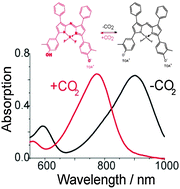NIR optical carbon dioxide sensors based on highly photostable dihydroxy-aza-BODIPY dyes†
Abstract
A new class of pH-sensitive indicator dyes for optical carbon dioxide sensors based on di-OH-aza-BODIPYs is presented. These colorimetric indicators show absorption maxima in the near infrared range (λmax 670–700 nm for the neutral form, λmax 725–760 nm for the mono-anionic form, λmax 785–830 nm for the di-anionic form), high molar absorption coefficients of up to 77 000 M−1 cm−1 and unmatched photostability. Depending on the electron-withdrawing or electron-donating effect of the substituents the pKa values are tunable (8.7–10.7). Therefore, optical carbon dioxide sensors based on the presented dyes cover diverse dynamic ranges (0.007–2 kPa; 0.18–20 kPa and 0.2–100 kPa), which enables different applications varying from marine science and environmental monitoring to food packaging. The sensors are outstandingly photostable in the absence and presence of carbon dioxide and can be read out via absorption or via the luminescence-based ratiometric scheme using the absorption-modulated inner-filter effect. Monitoring of the carbon dioxide production/consumption of a Hebe plant is demonstrated.


 Please wait while we load your content...
Please wait while we load your content...